High-Resolution Pixel LED Headlamps: Functional Requirement Analysis and Research Progress
Abstract
1. Introduction
2. Functional Requirement Analysis
2.1. Pixel Requirements for High-Resolution Headlamps
2.2. Variety of Beams for High-Resolution Headlamps
2.3. Stability of High-Resolution Headlamps
2.4. Legal Rationality of High-Resolution Headlamps
2.5. Fusion with Sensors for High-Resolution Headlamps
2.6. Personalized Customization of High-Resolution Headlamps
3. Research Progress of High-Resolution Headlamps
3.1. Structure and Performance of Existing High-Resolution Headlamps
3.2. Existing Beam Diversity of High-Resolution Headlamps
3.3. Existing Measures to Deal with System Stability of High-Resolution Headlamps
3.4. Review on High-Resolution Headlamp Prototypes
4. Conclusions
Author Contributions
Funding
Conflicts of Interest
References
- Hamm, M.; Audi, A.G. Real Driving Benefits and Research Findings with Digital Light Functions; ISAL: Darmstadt, Germany, 2019. [Google Scholar]
- Pham, T.A.; Yoo, M. Nighttime Vehicle Detection and Tracking with Occlusion Handling by Pairing Headlights and Taillights. Appl. Sci. 2020, 10, 3986. [Google Scholar] [CrossRef]
- Ameratunga, S.; Hijar, M.; Norton, R. Road-traffic injuries: Confronting disparities to address a global-health problem. Lancet 2006, 367, 1533–1540. [Google Scholar] [CrossRef]
- Rizvi, S.; Knöchelmann, M.; Ley, P.P.; Lachmayer, R. Survey of on-road image projection with pixel light systems. In Photonics, Devices, and Systems VII; International Society for Optics and Photonics: Bellingham WA, USA, 2017; Volume 10603, p. 1060314. [Google Scholar]
- Reinprecht, M.; Winterer, N.; Hartmann, P. Solution paths towards high-resolution adb-systems. In Proceedings of the 11th International Symposium on Automotive Lighting Bd. 16′; Khanh, T.Q., Ed.; Herbert Utz Verlag GmbH: München, Germany, 2015; pp. 177–186. ISBN 978-3-8316-4482-7. [Google Scholar]
- Moisel, J. Requirements for future high resolution adb modules. In Proceedings of the 11th International Symposium on Automotive Lighting (ISAL) Bd. 16′; Khanh, T.Q., Ed.; Herbert Utz Verlag GmbH: München, Germany, 2015; pp. 161–170. ISBN 978-3-8316-44814482-70. [Google Scholar]
- Brunne, D.; Kalze, F.-J. Outlook on high resolution pixel light. In Proceedings of the 12th International Symposium on Automotive Lighting (ISAL) Bd. 17′; Khanh, T.Q., Ed.; Herbert Utz Verlag GmbH: München, Germany, 2017; pp. 243–252. ISBN 978-3-8316-4671-5. [Google Scholar]
- Knöchelmann, M.; Held, M.P.; Kloppenburg, G.; Lachmayer, R. High-resolution headlamps–technology analysis and system design. Adv. Opt. Technol. 2019, 8, 33–46. [Google Scholar] [CrossRef]
- Rosenhahn, E.-O. New Systems for Safety and Comfort Improvementby High Resolution Flexibility; Vision Congress: Paris, France, 2018. [Google Scholar]
- Kleinkes, M.; Pohlmann, W.; Wilks, C. Boost Safety & Styling—New HD-LED Systems for Front and Rear; All HELLA GmbH & Co. KGaA: Lippstadt, Germany, 2017. [Google Scholar]
- Gut, C.; Cristea, I.; Neumann, C. High-resolution headlamp. Adv. Opt. Technol. 2016, 5, 109–116. [Google Scholar] [CrossRef]
- Qiao, F.; Rahman, R.; Li, Q.; Yu, L. Safe and environment-friendly forward collision warning messages in the advance warning area of a construction zone. Int. J. Intell. Transp. Syst. Res. 2017, 15, 166–179. [Google Scholar] [CrossRef]
- Hamm, M.; Huhn, W.; Reschke, J. Ideas for Next Lighting Generations in Digitalization and Autonomous Driving; World Congress Experience SAE International: Warrendale, PA, USA, 2018. [Google Scholar]
- Kanabe, A.; Samitsu, Y.; Takahashi, T.; Suzuki, K.; Ishida, H. Analysis on Collision Avoidance Behavior of Driver by Information Presentation of Advanced Light Distribution Control Headlamp; The Japan Society of Mechanical Engineers TRANSLOG: Ibaraki, Japan, 2018. [Google Scholar]
- Wilks, C.; Kubitza, B. HD-Headlamp Technologies and Development Process: From Simulation to Demonstration under Real Traffic; ISAL: Darmstadt, Germany, 2017. [Google Scholar]
- Schmidt, C. Adverse Weather Light: New Chances for a Technically Unsolved Problem; ISAL: Darmstadt, Germany, 2017. [Google Scholar]
- Rosenhahn, E.-O. Entwicklung von lichttechnischen Anforderungen an Kraftfahrzeugscheinwerfer für Schlechtwetterbedingungen; Herbert Utz Verlag: München, Germany, 2019. [Google Scholar]
- Thoma, A.; Vollrath, M. Adverse Weather Light—New Approaches to Evaluate Adaptive Light Functions; TU Braunschweig, L-Lab: Braunschweig, Germany, 2017. [Google Scholar]
- Ravier, J. Automotive Cameras for Lighting and Vision Systems; DVN Report; DVN: Oklahoma City, OK, USA, 2018. [Google Scholar]
- Gut, C.; Xilu, Z.; Boeke, B.; Daimler, A.G. Digital Light—The Future Light Distribution for Automated Vehicle; Daimler AG: Berlin, Germany, 2016. [Google Scholar]
- Janke, P.; Locher, J.; Hella GmbH & Co. KGaA; Peters, D. “Self-Healing” Measures for Matrix-LED-Headlamps; ISAL: Darmstadt, Germany, 2019. [Google Scholar]
- Draper, G. Global Simplification and Harmonisation of Regulations to Facilitate Innovation and Traffic Safety; ISAL: Darmstadt, Germany, 2017. [Google Scholar]
- Krieft, F.; Thoma, A.; Willeke, B.; Kubitza, B. Symbol Projections: Gain or Gadget? ISAL: Darmstadt, Germany, 2019. [Google Scholar]
- Polin, D.; Khanh, T.Q. Unterschungen zu Scheinwerfern Mit Hochauflösenden Projektionsmodulen; Automobiltechnische Zeitschrift; Springer: Berlin/Heidelberg, Germany, 2018. [Google Scholar]
- Azouigui, S.; Barbedette, B.; Saudrais, S.; Sortais, Y. Impact of Advanced Lighting Function Based on Road Projection for Departing Indication in Parking Lots; ISAL: Darmstadt, Germany, 2019. [Google Scholar]
- Azouigui, S. Advanced Lighting Functions with High-Resolution Road Projection; Vision Congress: Paris, France, 2018. [Google Scholar]
- Austerer, M.; Holzbauer, M.; Künzel, C.; Rosenauer, M. Sensor Fusion for Dynamic High-Resolution Lighting; ISAL: Darmstadt, Germany, 2019. [Google Scholar]
- Cochard, J.; Bouyé, C. From advanced driver assistance to autonomous driving: Perspectives for photonics sensors. In Photonic Instrumentation Engineering III; International Society for Optics and Photonics: Bellingham WA, USA, 2016; Volume 9754, p. 975409. [Google Scholar]
- Hartmann, P.; Weissensteiner, S. Integration of Sensors in Headlamps, Leading to a Multifunctional Component for Environmental Perception; ZKW Group GmbH: Wieselburg, Austria, 2017. [Google Scholar]
- Damasky, J. Lichttechnische Entwicklung von Anforderungen an Kraftfahrzeug—Scheinwerfer. Ph.D. Thesis, Technische Hochschule Darmstadt, Darmstadt, Germany, 1995. [Google Scholar]
- Huhn, W. Anforderungen an Eine Adaptive Lichtverteilung für Kraftfahrzeug Scheinwerfer im Rahmen der ECE-Regelungen. Ph.D. Thesis, Technische Universität Darmstadt, Darmstadt, Germany, 1999. [Google Scholar]
- Diem, C. Blickverhalten von Kraftfahrern im dynamischen Straßenverkehr. Ph.D. Thesis, Technische Universität Darmstadt, Darmstadt, Germany, 2005. [Google Scholar]
- Wagner, M.; Erkan, A.; Kosmas, K. Reducing Head Lighting Level on Urban Roads for Different Street Lighting Situations; ISAL: Darmstadt, Germany, 2019. [Google Scholar]
- Kobbert, J. Optimization of Automotive Light Distributions for Different Real Life Traffic Situations. Ph.D. Thesis, Technische Universität Darmstadt, Darmstadt, Germany, 2018. [Google Scholar]
- Neitzke, C. Democratization of Advanced Driving Beam Systems—Good Light for Everyone! ISAL: Darmstadt, Germany, 2019. [Google Scholar]
- Bhakta, V.; Ballard, B. High Resolution Adaptive Headlight Using Texas Instruments DLP® Technology; ISAL: Darmstadt, Germany, 2015. [Google Scholar]
- Elger, G.; Spinger, B.; Bienen, N.; Benter, N. LED matrix light source for adaptive driving beam applications. In Proceedings of the 2013 IEEE 63rd Electronic Components and Technology Conference, Las Vegas, NV, USA, 28–31 May 2013; pp. 535–540. [Google Scholar]
- Berlitz, S.; Hamm, M.; Funk, C. Audi Matrix LED Headlights. ATZ Worldw. 2014, 116, 4–9. [Google Scholar] [CrossRef]
- Fiederling, R. “Smartrix” a new chapter in the smart matrix LED lighting. ATzelektronik Worldw. 2017, 12, 50–55. [Google Scholar] [CrossRef]
- Schettler, M.; Memedi, A.; Dressler, F. The chosen one: Combating VLC interference in platooning using matrix headlights. In Proceedings of the 2019 IEEE Vehicular Networking Conference (VNC), Los Angeles, CA, USA, 4–6 December 2019; pp. 1–4. [Google Scholar]
- Chen, W.; Fan, J.; Qi, G.; Sun, C.; Yang, W.; Cao, S. Optical and thermal designs of LED matrix module used in automotive headlamps. In Proceedings of the 2019 16th China International Forum on Solid State Lighting & 2019 International Forum on Wide Bandgap Semiconductors China (SSLChina: IFWS), Shenzhen, China, 25–27 November 2019; pp. 220–224. [Google Scholar]
- Groetsch, S.; Reill, J.; Schwind, M.; Haneder, S.; Hiller, U. Illumination vs. Visualization in Headlamps: Way towards HD Light Source Requirements; SIA VISION: Paris France, 2018. [Google Scholar]
- Trommer, J.; Feil, T.; Wild, M. LED Modules for High-resolution Matrix Headlamps. ATZ Worldw. 2019, 121, 26–31. [Google Scholar] [CrossRef]
- Grötsch, S.G.; Brink, M.; Fiederling, R.; Liebetrau, T.; Möllers, I.; Moisel, J.; Oppermann, H.; Pfeuffer, A. μAFS High Resolution ADB/AFS Solution; SAE Technical Paper; SAE: Warrendale, PA, USA, 2016. [Google Scholar]
- Trommer, J.; Feil, T.; Weissenberger, D.; Fiederling, R.; Rayre, M. New Possibilities with µAFS modules—The Path to High-Resolution Full-Matrix Headlamps. In Proceedings of the 12th International Symposium on Automotive Lighting (ISAL) Bd. 17′; Khanh, T.Q., Ed.; Herbert Utz Verlag GmbH: München, Germany, 2017; pp. 333–342. ISBN 978-3-8316-4671-5. [Google Scholar]
- Brunne, D.; Kalze, F.-J. Outlook on high resolution pixel light. In Proceedings of the 12th International Symposium on Automotive Lighting, Darmstadt, Germany, 25–27 September 2017; pp. 243–251, ISBN 978-3-8316-4672-2. [Google Scholar]
- Moellers, I.; Moisel, J.; Fiederling, R.; Grötsch, S. Ein Effizienter Hochauflö-Sender ADB-Scheinwerfer auf Basis von Mikrointegrierten LED-Arrays; VDI Wissensforum: Düsseldorf, Germany, 2016. [Google Scholar]
- Held, M.P.; Kloppenburg, G.; Lachmayer, R. Micro Pixel LEDs–Design Challenge and Implementation for High-Resolution Headlamps. In Light-Emitting Devices, Materials, and Applications; International Society for Optics and Photonics: Bellingham, WA, USA, 2019; Volume 109401U. [Google Scholar] [CrossRef]
- Knöchelmann, M.; Wolf, A.; Kloppenburg, G.; Lachmayer, R. Aktiver Schein-werfer mit DMD-Technologie zur Erzeugung vollständiger Lichtverteilungen. VDI Ber. 2018, 2323, 61–78. [Google Scholar] [CrossRef]
- Roth, J.; Thamm, M.; Held, P. Micro-Pixel-LED-Headlights; ISAL: Düsseldorf, Germany, 2019. [Google Scholar]
- Cladé, S.; Courcier, M.; Roels, S.; Pellarin, M. 4K pixel solid state glare free high beam. In Proceedings of the 13th International Symposium on Automotive Lighting, Darmstadt, Germany, 23–25 September 2019. [Google Scholar]
- Werner, K. A Paradigm Shift in Autonomous Cars (and More) at Vehicle Displays. Inf. Disp. 2019, 35, 24–29. [Google Scholar] [CrossRef]
- Maier, M.; Moisel, J.; Herold, F. Multibeam Headlights in the Mercedes-Benz CLS-Class. ATZ Worldw. 2015, 117, 4–9. [Google Scholar] [CrossRef]
- Kim, T.K.; Cho, M.U.; Lee, J.M.; Cha, Y.J.; Oh, S.K.; Chatterjee, B.; Ryou, J.H.; Choi, S.; Kwak, J.S. Improved Light Output Power of 16 × 16 Pixelated Micro-LEDs for Headlights by Enhancing the Reflectivity and Coverage of the p-Electrode. Phys. Status Solidi 2018, 215, 1700571. [Google Scholar] [CrossRef]
- Reiss, B. DVN Workshop. In “New Front & Rear Functionalities Thanks to High Pixelisation” Road Marking Solutions with Pixelized Light Source B; Reiss, S.C., Ed.; Valeo Lighting Systems: Saint-Denis, France; Shanghai, China, 2017. [Google Scholar]
- Kim, H.-D.; Kim, J.-U. High Resolution Pixel Lamp; ISAL: Düsseldorf, Germany, 2019. [Google Scholar]
- Lee, J.; Ko, G.; Lee, J. Implementation of Pixel Technology for Automotive Lighting System Based on Wafer-Level Process; ISAL: Düsseldorf, Germany, 2019. [Google Scholar]
- Choi, E.J.; Park, H.S. Adaptive Driving Beam (ADB) with Variable Color Temperature for Enhanced Visibility; ISAL: Düsseldorf, Germany, 2019. [Google Scholar]
- Zhang, Y.; Tang, J.; Wang, J.; Liu, N.; Wang, F.; Geng, D. Adjustable beam lighting with LED matrix and lens array. J. Soc. Inf. Disp. 2017, 25, 496–503. [Google Scholar] [CrossRef]
- Li, Y.; Knöchelmann, M.; Lachmayer, R. Beam Pre-Shaping Methods Using Lenslet Arrays for Area-Based High-Resolution Vehicle Headlamp Systems. Appl. Sci. 2020, 10, 4569. [Google Scholar] [CrossRef]
- Beddar, S.; Millet, J.B.; Alayli, Y. Pixelated-LEDs Car Headlight Design for Smart Driving and CO2 Reduced Emissions; SAE Technical Paper; SAE: Warrendale, PA, USA, 2020. [Google Scholar]
- Li, J. A Matrix Headlamp Design Based on Artificial Intelligence Controller Control. J. Phys. Conf. Ser. 2020, 1574, 012091. [Google Scholar] [CrossRef]


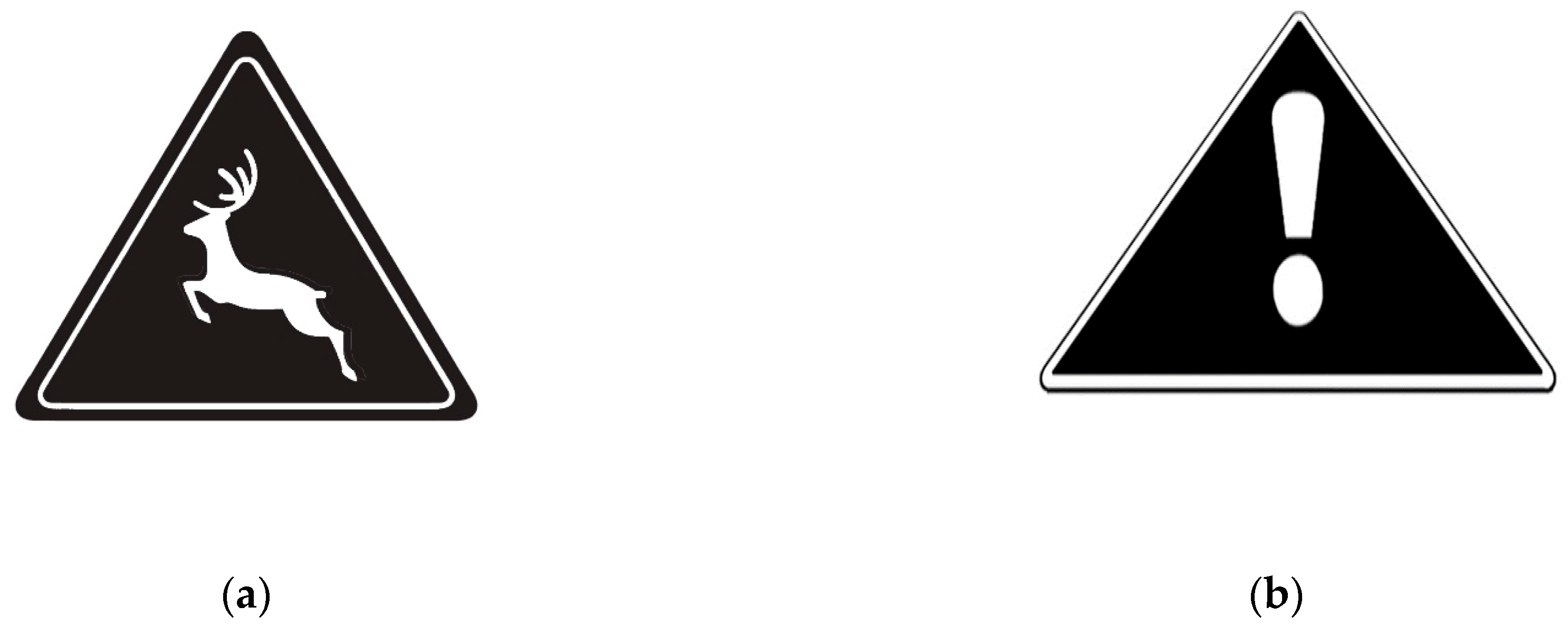

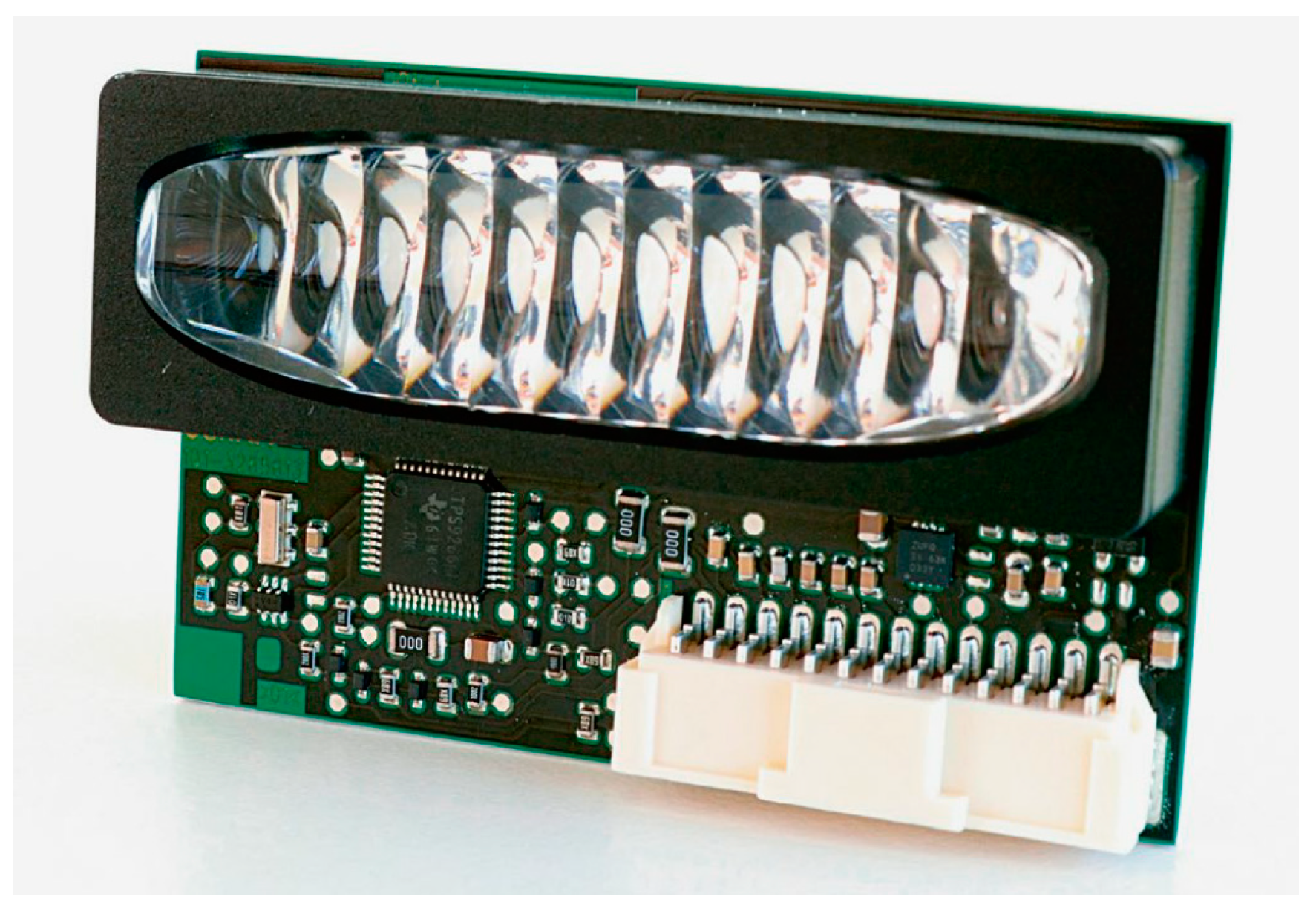
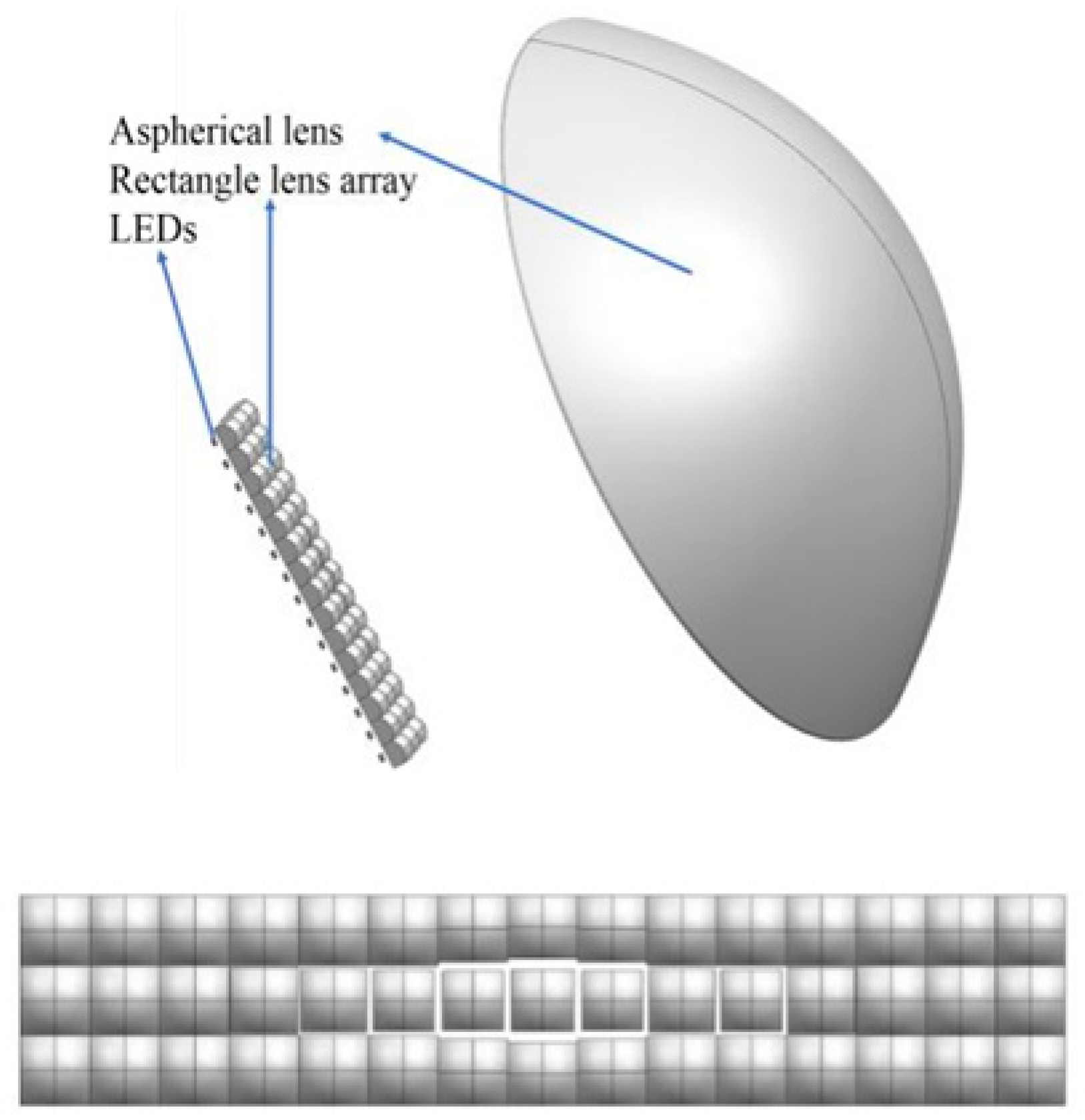
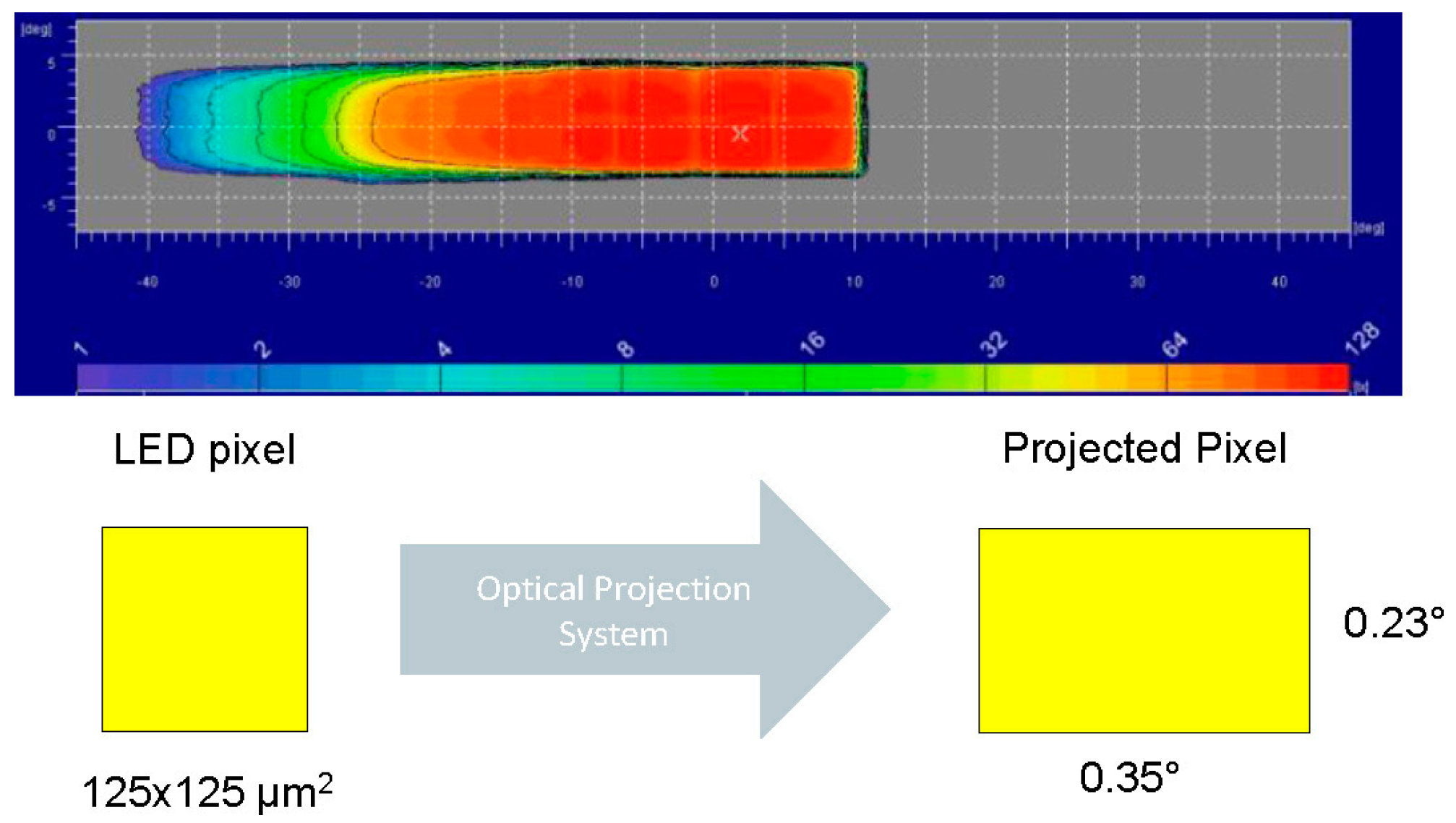

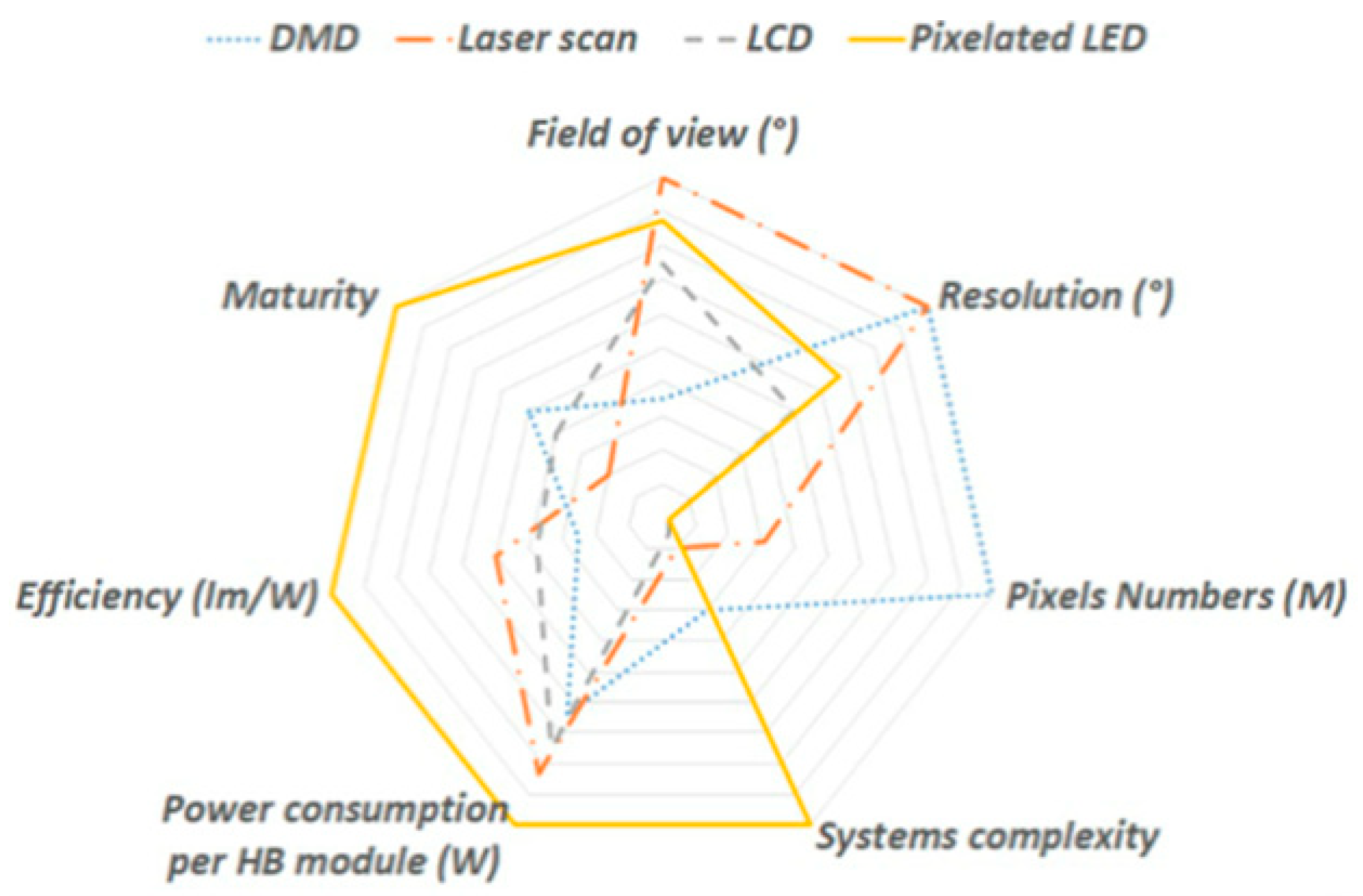
Publisher’s Note: MDPI stays neutral with regard to jurisdictional claims in published maps and institutional affiliations. |
© 2021 by the authors. Licensee MDPI, Basel, Switzerland. This article is an open access article distributed under the terms and conditions of the Creative Commons Attribution (CC BY) license (https://creativecommons.org/licenses/by/4.0/).
Share and Cite
Wang, L.; Ma, J.; Su, P.; Huang, J. High-Resolution Pixel LED Headlamps: Functional Requirement Analysis and Research Progress. Appl. Sci. 2021, 11, 3368. https://doi.org/10.3390/app11083368
Wang L, Ma J, Su P, Huang J. High-Resolution Pixel LED Headlamps: Functional Requirement Analysis and Research Progress. Applied Sciences. 2021; 11(8):3368. https://doi.org/10.3390/app11083368
Chicago/Turabian StyleWang, Liping, Jianshe Ma, Ping Su, and Jianwei Huang. 2021. "High-Resolution Pixel LED Headlamps: Functional Requirement Analysis and Research Progress" Applied Sciences 11, no. 8: 3368. https://doi.org/10.3390/app11083368
APA StyleWang, L., Ma, J., Su, P., & Huang, J. (2021). High-Resolution Pixel LED Headlamps: Functional Requirement Analysis and Research Progress. Applied Sciences, 11(8), 3368. https://doi.org/10.3390/app11083368






